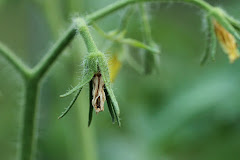 I get excited about kale because it is by far my favorite cooked green. When steamed, it retains more texture than spinach. It can also be chopped raw and used in salads. Kale is a good source of vitamin A and calcium. Mostly, I just like the taste, appearance in the garden and ease of growing.
I get excited about kale because it is by far my favorite cooked green. When steamed, it retains more texture than spinach. It can also be chopped raw and used in salads. Kale is a good source of vitamin A and calcium. Mostly, I just like the taste, appearance in the garden and ease of growing.Grow kale as a cool season vegetable in spring and again for fall, filling in with a warm season succession crop in summer. I planted mine before the end-of-March for seed to reap moisture from Front Range spring snowfalls. Do plant by mid April to squeeze in a crop before weather potentially turns hot in June. Quality decreases in hot weather and leaves can turn stringy. Turn to growing more heat-tolerant collards for summer cabbage family greens.
 Kale is a tough, pioneer crop for gardeners planting new ground. The round, pellet-shaped seeds are planted only ¼ inch deep (seedlings photo left). Although not as small as lettuce seed, I cover with seed germination fabric to combat soil drying from strong spring winds and intense Colorado sun (see March 6 post, "Seed germination in Dry Climates").
Kale is a tough, pioneer crop for gardeners planting new ground. The round, pellet-shaped seeds are planted only ¼ inch deep (seedlings photo left). Although not as small as lettuce seed, I cover with seed germination fabric to combat soil drying from strong spring winds and intense Colorado sun (see March 6 post, "Seed germination in Dry Climates").Plants mature in approximately 2 months but leaves can be harvested at any stage of development. Pluck leaves from the outside, allowing plants to push new leaf replacements from the interior to extend the harvest. The new interior leaves are tender and best for salads. Kale stores exceptionally well in the refrigerator.
This year, my spring crop variety is ‘Lacinato’, also known as ‘Toscano’ or dinosaur kale due to the variety’s dark, puckered leaves (left seed packet above). ‘Red Winter’ also known as ‘Red Russian’ is a rugged-looking heirloom variety good eaten raw in salads (right seed packet above). The most widely grown variety in the U.S. is ‘Vates Dwarf Blue Curled’, a ruffled leaf variety developed in Virginia in 1950 (center seed packet above). For an ornamental but edible touch, plant the red-purple leafed ‘Redbor F1’. Keep in mind that the red color develops better in cool, fall weather than in summer heat so planting mid-summer for a fall crop should be considered.
Kale is relatively pest free but occasionally can develop cabbage aphids.
[Kale seed packets and seedling photo credit, Carl Wilson]

 Peas are a snap when you plant early. In fact, research shows you can enjoy a 50 percent higher yield by planting April 1 or earlier than if you delay until May 1. The name of the game really is to sneak peas in during cool spring weather before Front Range summer heat arrives. We don’t tend to have too much mild temperature weather in-between to keep vines going.
Peas are a snap when you plant early. In fact, research shows you can enjoy a 50 percent higher yield by planting April 1 or earlier than if you delay until May 1. The name of the game really is to sneak peas in during cool spring weather before Front Range summer heat arrives. We don’t tend to have too much mild temperature weather in-between to keep vines going.







